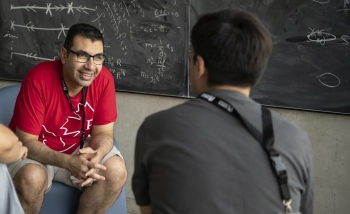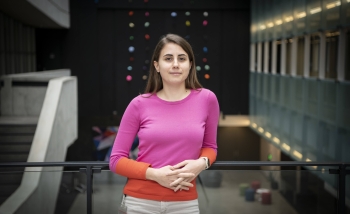Jaume Gomis takes a pen and rolls it across his desk. This leading mind in quantum field theory is turning his attention (briefly) to experiment.
“You probably have a good intuition for this,” he says. “For example, you know that the pen will go in the direction you push it. It will go faster if you push it harder. It might skitter as the cap catches.”
It does, and then crashes into a pile of papers. All of that was predictable. Almost nothing else in Gomis’s research works this way.
Gomis, one of Perimeter’s senior faculty members, studies the physics of objects that are much smaller and, in principle, simpler than pens: the quarks and gluons which make up the protons and neutrons of everyday matter. The behaviour of the pen is governed (roughly) by the laws of classical mechanics. The behaviour of quarks and gluons is governed by the laws of something called quantum chromodynamics, or QCD.
But while predicting the behaviour of the pen is high school physics, predicting the behaviour of the quarks is extremely difficult – often impossible. We can do it for quarks interacting over very short distances, or at very high energies, where quantum effects are tame. But at the lower energies and larger scales we can actually observe on Earth, the surprising and non-classical behaviour of quantum mechanics reigns. [Why is low-energy QCD in such a snarl? See sidebar below.]
Perimeter Institute Faculty member Jaume Gomis.[/caption]
Gomis describes the way our classical approaches and intuition fail. “It’s as if, instead of sliding across the table with a bit of skittering, the pen ran off to Las Vegas to form a band,” he says. “What’s happening here is that strong quantum effects reorganize the quarks and gluons into systems whose dynamics are entirely different than the ones we see at high energies.”
When it comes to QCD at everyday energies, our intuition is not a reliable guide and our calculations from first principles fail us. This is a situation Gomis is determined to change, and, in what’s already being called a major step forward for the field, he’s having some success.
Reformulating for low energies
Gomis is working with a particular subset of QCD known as QCD3. The “3” refers to the number of dimensions in the theory: two of space and one of time. That’s obviously different than a theory of QCD for all four dimensions of the known universe, but it’s not as impractical as it sounds: many real-world condensed matter systems are best described using QCD3. That includes several types of condensed matter whose properties could be useful in quantum computing.
That makes what Gomis did next both a theoretical leap forward and a practical advance that’s sure to catch the eye of experimentalists. By deploying a variety of recent developments from the forefront of particle physics, condensed matter physics, and pure mathematics, Gomis developed a new mathematical formulation of QCD3 that can be used to predict the dynamics of systems at low energies.
Asked to dive deeper into the principles that guided his reformulation of QCD3, Gomis demurs. “It’s extremely technical,” he says. “Call it an educated guess.”
It was clearly a very, very educated guess. But that leads to a question: how does Gomis know his guess was right?
It turns out that quantum chromodynamics makes a handful of predictions that are the same at all energies and all length scales. These calculated results, known technically as “anomalies,” can act as fixed stars, making sure the theory is on the right course.
Here’s how. Remember that physicists have long been able to work with high-energy QCD; it’s the low-energy counterpart which has been the problem. To check his theory, Gomis first used the existing high-energy QCD3 and calculated the theory’s anomalies. Then, with some trepidation, he used his reformulated low-energy QCD to calculate the same anomalies. Because anomalies are the same at high energies as at low energies, he knew the calculations should match.
And they did. “It was the most beautiful thing, the most astonishing thing,” Gomis says. The anomalies at low energy lined up with those from high energy like stars with a star-chart.
This work is considered a breakthrough in the subfield and it has opened new lines of research by both Gomis and the community. There have been further insights and conjectures on the low-energy dynamics of QCD theories, including concrete predictions for the low-energy dynamics that can now begin to be tackled by large-scale computer simulations.
With the “stars” aligned and the work ongoing, it seems that in the long quest for a workable version of low-energy QCD, Jaume Gomis has set a promising course.
The problem with low-energy QCD
Low-energy QCD is in such a snarl because, in the parlance of the field, it is non-perturbative.
Most everyday physics is perturbative. Practically speaking, that means we can make rough calculations based on approximations, and then dial in on more correct answers through a series of small corrections. To perturb something is to give it a little knock. If you bumped into a swinging pendulum, the resulting motion would probably be a swing with a wobble in it. If you wanted to describe the motion mathematically, you could get close by writing down the well-known equations for the basic swing and then adding a bit of math to represent the wobble. The pendulum has been perturbed, and perturbative methods can be applied.
A non-perturbative pendulum would be a different story. The wobble would likely be bigger than the swing, and the resulting motion a complex mixture of both. In any calculation, both the wobble and the swing (and any other complicated factors) would have to be included from the beginning. Describing the dynamics of this pendulum is obviously much, much more challenging than describing the dynamics of a perturbative pendulum.
Many non-perturbative physics problems have not been solved analytically at all. This is particularly true of problems that are far from the classical realm, where quantum effects rule. Low-energy QCD is a morass of such problems – which makes charting a course through it particularly hard.
Further exploration
About PI
Perimeter Institute is the world’s largest research hub devoted to theoretical physics. The independent Institute was founded in 1999 to foster breakthroughs in the fundamental understanding of our universe, from the smallest particles to the entire cosmos. Research at Perimeter is motivated by the understanding that fundamental science advances human knowledge and catalyzes innovation, and that today’s theoretical physics is tomorrow’s technology. Located in the Region of Waterloo, the not-for-profit Institute is a unique public-private endeavour, including the Governments of Ontario and Canada, that enables cutting-edge research, trains the next generation of scientific pioneers, and shares the power of physics through award-winning educational outreach and public engagement.
You might be interested in


Perimeter Hosts Strings 2023: Spotlighting new directions and uniting a community
September 22, 2023

